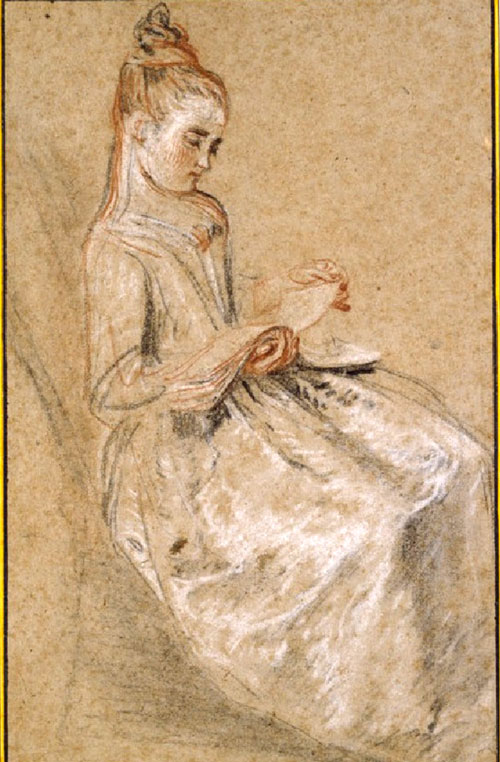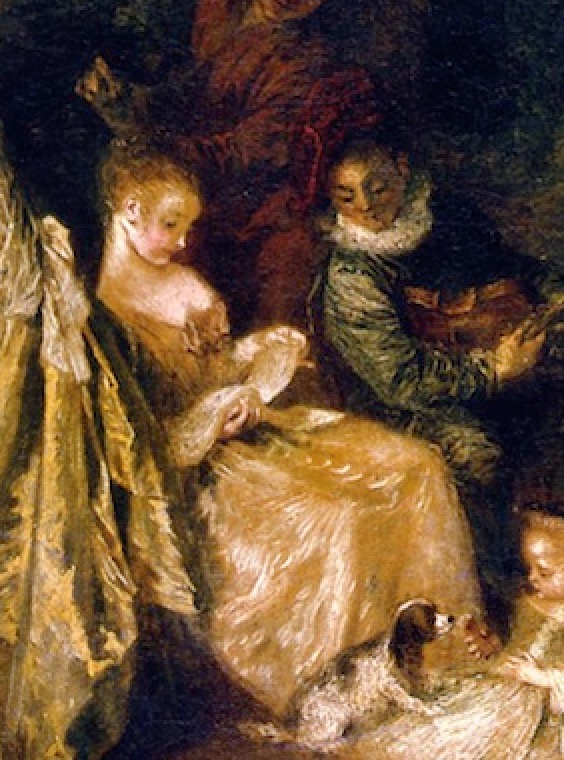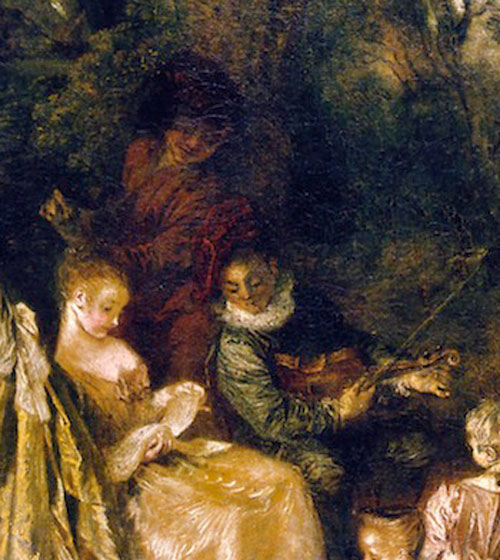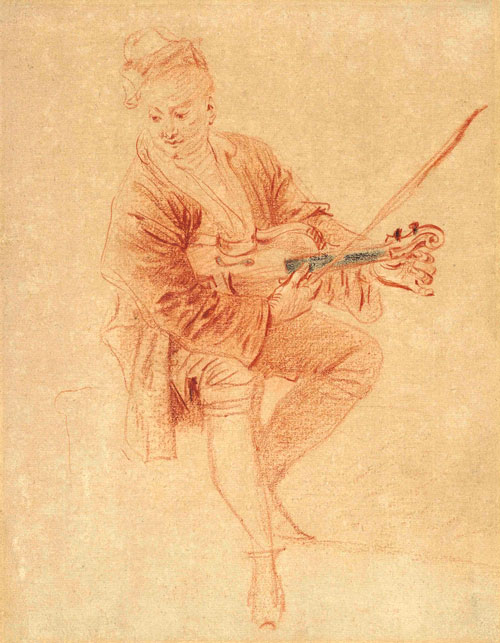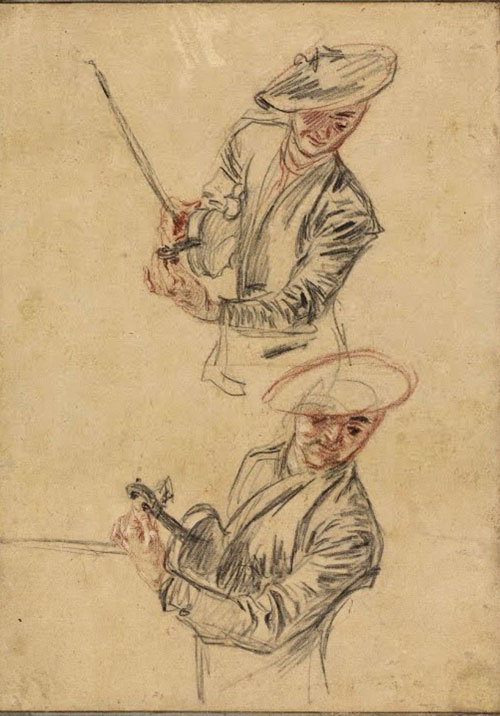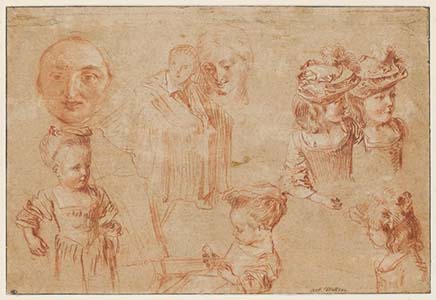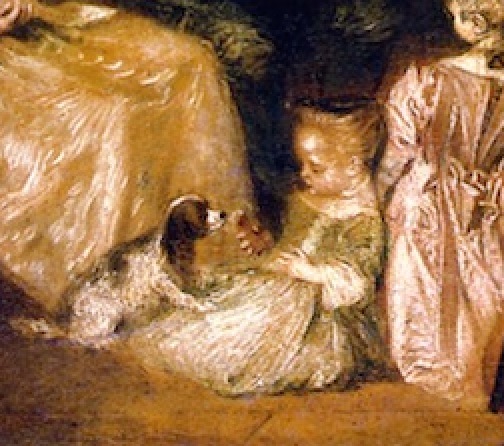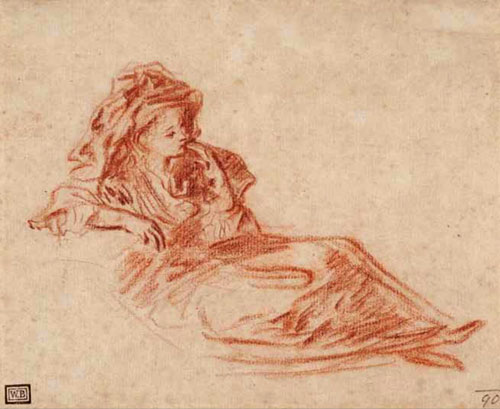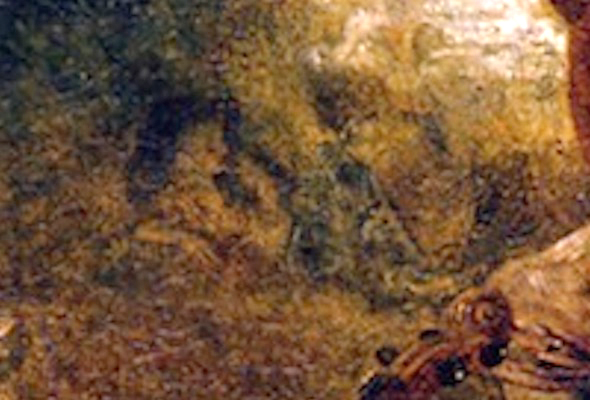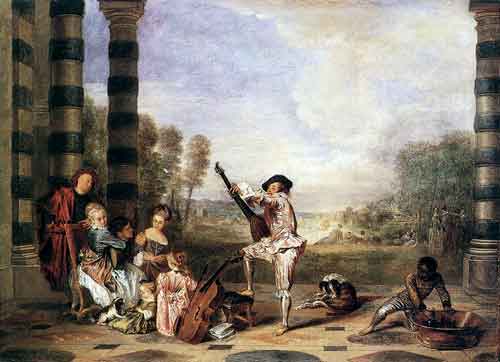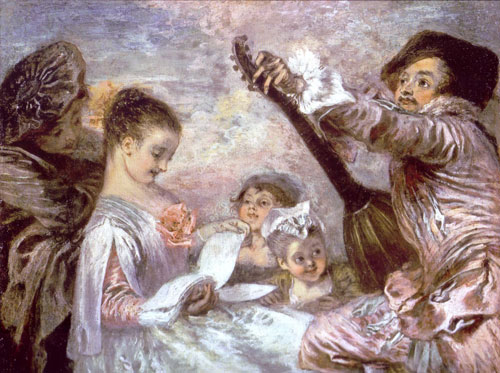
- Home Page
- Accepted
Paintings & Copies - Doubtful
Attributions - Doubtful Textual References
- Alternative
Titles - Collectors &
Museums - Bibliography
- Search Abecedario
- Watteau &
His Circle
Le Concert
Entered January 2019; revised January 2020
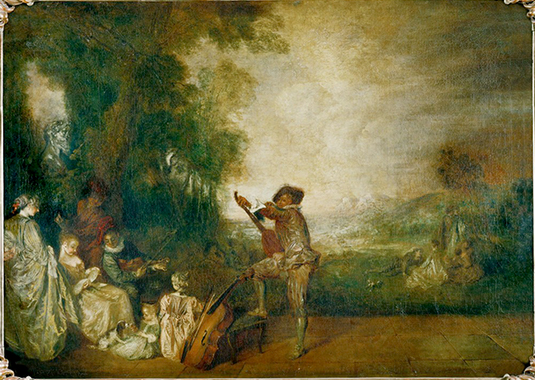
Berlin, Schloss Charlottenburg, Staatliche Schlösser und Gärten
Oil on canvas
66 x 91 cm
ALTERNATIVE TITLES
Un Concert
Fête galante mit Musikierenden an einer Dionysosbüste
Gathering in the Open with Violinists and Bass Guitarists
Das Konzert
La Leçon de musique
Prélude au concert
Prelude to a Concert
RELATED PRINTS
The painting was not engraved for Jean de Jullienne’s Oeuvre gravé.
PROVENANCE
Paris, collection of Louis Quentin de l’Orangère (d. 1743; greffier des présentations au Châtelet de Paris, receveur de la signature en chef du Châtelet de Paris). His sale, Paris, March 22ff, 1744, lot 34: “Un Concert, par A. Watteau, de 2 pieds 10 pouces ½ de larg, sur 2 pieds de haut.” Sold for 351 livres according to the annotated copy of the sale catalogue in the Rijksbureau voor Kunsthistorische Documentatie.
Berlin, collection of Frederick II [Frederick the Great] (1712-1786; king of Prussia). From 1773 until 1941 it was recorded in the Audience Room at Schloss Sans Souci
EXHIBITIONS
Berlin, Königliche Akademie, Gemälde älterer Meister im berliner Privatsbesitz (1883), 229 cat. 1 (by Watteau, Das Konzert, lent by Kaiser Wilhelm).
Wiesbaden, Malerei des 18. Jahrhunderts (1947), cat. 117 (by Watteau, Das Konzert, VSG).
Wiesbaden, Französische Kunst (1951), cat. 56 (by Watteau, Das Konzert, VSG).
Stockholm, Fem Sekler Fransk Konst (1958), cat. 63 (Watteau, Konserten or Musiklektionen, lent by the Ehem. Staatliche Schlösser und Gärten, Berlin-Charlottenburg)
Berlin, Meisterwerke aus den Schlössern Friedrichs des Grossern (1962), cat. 93 (by Watteau, Das Konzert).
Paris, La Peinture française à la cour de Frederich (1963), cat. 33 (by Watteau, Le Concert, lent by the Staatliche Schlösser und Gärten).
Washington, Paris, Berlin, Watteau 1684-1721 (1984), cat. P48 (by Watteau, Prelude to a Concert [formerly The Concert] [Le prélude au concert], Schloss Charlottenburg).
SELECT BIBLIOGRAPHY
Osterreich, Description (1773), cat. 266.
Dohme, “Zur Literatur über Watteau” (1876), 91, cat. 11.
Seidel, Collections d’oeuvres d’art françaises (1900), cat. 151.
Zimmermann, Watteau (1912), pl. 12.
Réau, “Watteau” (1928), cat. 117.
Adhémar, Watteau (1950), cat. 191.
Nordenfalk, Watteau och andra franska sjuttonhundratalsmästare (1953), 133.
Junecke, “Meisterwerke aus den Schlössern Friederichs des Grossen” (1962), 68.
Macchia and Montagni, L’opera completa di Watteau (1968), cat. 179.
Ferré, Watteau, 1972, cat. A23.
Roland Michel, Watteau (1981), cat. 216.
Roland Michel, Watteau (1984), 209, 229, 270, 271.
Posner, Watteau (1984), 157, 160, 173.
Vogtherr, ''Fêtes galantes in London and Potsdam” (2009-10), 180-86.
Rosenberg and Prat, Watteau, Catalogue raisonné des dessins (1996), cat. 229, 443, 590, 593, 594, R454.
Temperini, Watteau (2002), 102, cat. 90.
Glorieux, Watteau (2011), 217.
Vogtherr, Französische Gemälde (2011), 132-41, cat. 3.
RELATED DRAWINGS
Five extant drawings and another recorded in an engraving can be directly related to figures in Le Concert.
The woman reading a score book was taken with little change from an elegant drawing now in the Ashmolean Museum.
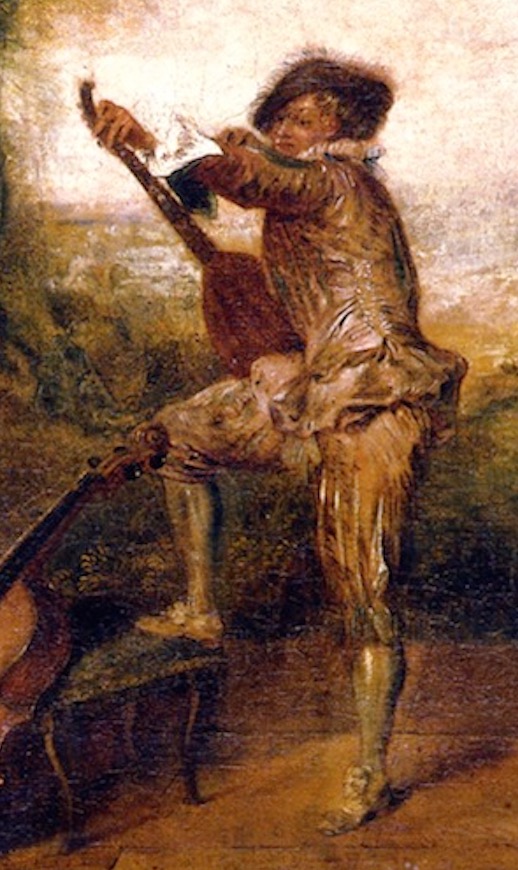
Watteau, Le Concert (detail).
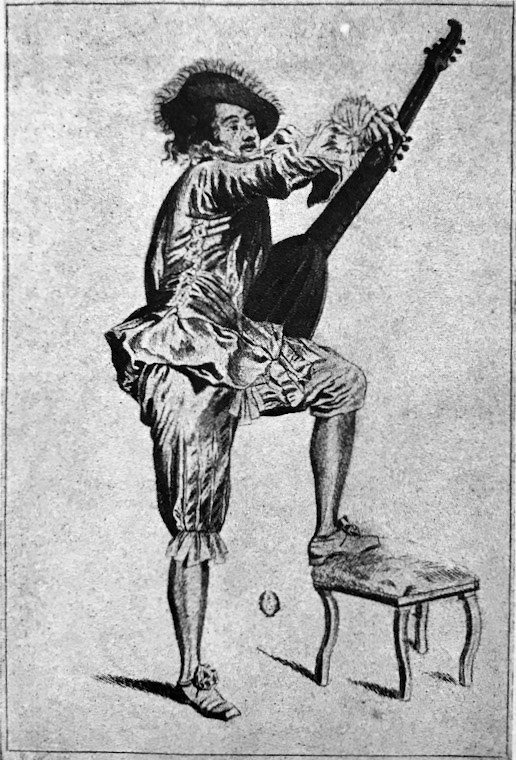
Bernard or Jean Audran after Watteau, Standing Theorbo Player, engraving. Paris, Bibliothèque de l’Arsenal.
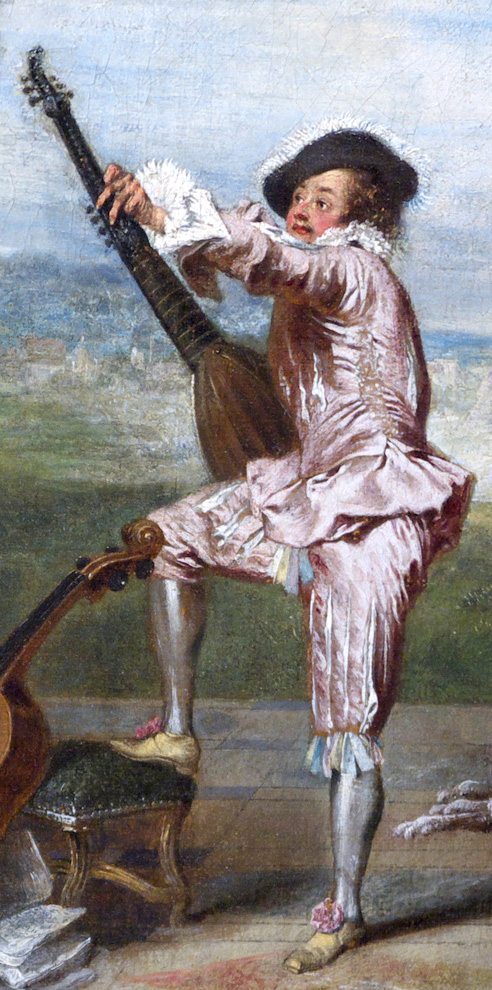
Watteau, Les Charmes de la vie (detail).
The second principal figure in Le Concert is that of the standing musician, dressed as Mezzetin, who is tuning his theorbo, an instrument popular among French seventeenth- and eighteenth-century musicians. The drawing for this musician has not survived but it was recorded in reverse in an engraving by Bernard or Jean Audran for the Figures de différents caractères. However, the print was ultimately not included in Jullienne’s corpus, but an impression of it is preserved in the Bibliothèque de l’Arsenal, Paris. This same musician also appears in Les Charmes de la vie and La Leçon de musique, although in the latter work his lower legs are cut from view by the frame. Whether Watteau turned here to his original drawing, or whether he based himself upon the musician in Les Charmes de la vie is moot.
The two violinists seen in Le Concert—one seated and the other standing—are derived from two very different drawings. Watteau’s close friend Nicolas Vleughels posed for the seated violinist, in a delicate red chalk study (Rosenberg and Prat 593). The standing violinist was drawn in a bolder, more incisive manner (Rosenberg and Prat 594). It should be noted that this second violinist was not originally included in this group of musicians; his absence can be seen in x-rays of this section of the canvas.
The seated child leaning back was selected from a complex sheet of studies in the Louvre, some early and those of the child drawn later (Rosenberg and Prat 229). Watteau used the child at the bottom center. Originally the bottom portions of her skirt must have been present and this is recorded in the painting, but at a later date the drawing was cut across at the bottom edge, eliminating that portion of her skirt.
Although the people in the distant backgrounds of Watteau’s fêtes galantes are often evocative of figures seen elsewhere in his oeuvre, they rarely can be traced to specific drawings or models. In this instance, however, the woman seated near the center of the composition (diminutive because she is set so far back), her head covered by a mantoue or shawl, can be traced to a study in the Snite Museum (Rosenberg and Prat R454). The drawing is somewhat problematic because the upper half of her body is superior in execution and of a different colored red chalk than the lower area of the skirt. Although Rosenberg and Prat rejected the drawing, it seems more likely that the upper portion was drawn by Watteau, while the lower portion was filled out by a less skilled draftsman. The same woman—still just half length—appears in Plaisirs d’amour.
REMARKS
Although not engraved and not in the best condition, especially at the left side, this painting has been little questioned as a Watteau. Its history extends back to the eighteenth century and, as well, the drawings associated with the composition help support the attribution.
Until now, the provenance of this painting has not been traced further than the 1770s when the work was in Berlin. We believe that it may well be the “Concert” that was owned by the noted collector of Watteau’s art, Quentin de l’Orangère. When his picture was sold in 1744 it was measured at 61 x 87.6 cm, which is just slightly short of the 66 x 91 cm that it measures today. Certainly the announced subject of “Un Concert” fits the present picture. The time frame allows it to have been bought at the 1744 sale or even a decade or two later. If Quentin de l’Orangère’s Concert was another picture, which large-size Watteau might it have been? Faute de mieux, it seems reasonable to look at Quentin de l'Orangère's collection for filling out the painting’s earliest history.
Le Concert is closely related to two other paintings that are firmly rooted in Watteau’s established oeuvre: the relatively large Les Charmes de la vie and the small La Leçon de musique, Coincidentally, both are now in the Wallace Collection. Each has certain figures in common with Le Concert. The only figure that all three share is the standing lutenist. But, even then, this musician is seen in full in Le Concert and Les Charmes de la vie, but not in La Leçon de musique where about one third of his body is cropped by the frame. Of the other characters in the Berlin painting, only the two children are found in Les Charmes de la vie, while the woman reading her score book in the Berlin painting is found only in La Leçon de musique. Although the three paintings resemble each other, in fact, they remain quite independent. Watteau rarely repeated himself in full.
The dating of Le Concert has generally centered around the years 1717-18. Sharing this opinion are Roland Michel as well as Rosenberg and Prat. In giving some of the preliminary drawings to c. 1718-19, Grasselli allowed the painting to be slightly later. On the other hand, Posner suggested 1715-16, and more recently Vogtherr also suggested an early date of 1715-17. The dating of this painting is extremely vexing, especially because of the poor, flat rendering and the problems caused by overpainting. The figures are clumsy rather than delicate. A good case in point is the seated violist; in the drawing, the model (presumably Nicolas Vleughels) has a well-defined face and the fingers of his left hand are carefully articulated; just the opposite is true in the painting where the forms are flat and generalized, if not clumsy. The standing woman at the left, especially her unfortunate profile, is particularly disturbing and uncharacteristic of Watteau. Would a careful restoration of the picture reveal the artist’s intention and skill?
An intriguing interpretation of the picture was offered by Albert de Mirimonde and continued by Rosenberg, Posner, and others. They emphasize that the painting does not show a concert but rather the preparations for one. The lutenist is tuning his theorbo (an instrument with a reputation for being difficult to keep in tune), the cello has already been tuned and the cellist has walked away, the woman is looking over the score prior to singing. Thus Rosenberg renamed the painting Le Prélude au concert, a title that has been employed widely since 1984 but not by all—e.g., not by Vogtherr. Some elements of this newer interpretation are open to question. One cannot be certain that the cello has been tuned and that the cellist has walked away; indeed, we cannot be certain that any cellist was present and the cello could be just a decorative element of still life. Even more unlikely is Mirimonde's proposal that the woman has grown impatient with the lutenist’s preparations and will be more responsive to the violinist who peers too attentively over her shoulder. Watteau’s paintings are generally more nuanced and defy such explicit narratives. Moreover, although Mirimonde, Posner, and others have emphasized the fragility of amorous relationships, a mood often projected onto Watteau’s art, this scene of a musician fine-tuning his instrument could perhaps be read as emphasizing the harmony that with effort can be achieved in both music and society.
For copies of Le Concert, CLICK HERE
